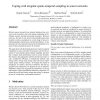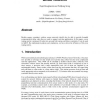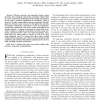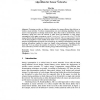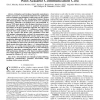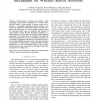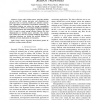COMCOM
2007
13 years 11 months ago
2007
The past few years have witnessed increased interest in the potential use of wireless sensor networks (WSNs) in applications such as disaster management, combat field reconnaissa...
CCR
2004
13 years 11 months ago
2004
Wireless sensor networks have attracted attention from a diverse set of researchers, due to the unique combination of distributed, resource and data processing constraints. Howeve...
VLSISP
2008
13 years 11 months ago
2008
Besides energy constraint, wireless sensor networks should also be able to provide bounded communication delay when they are used to support real-time applications. In this paper,...
TWC
2008
13 years 11 months ago
2008
Wireless networks, and especially wireless sensor networks, have complexity and energy constraints, within which they must confront the challenging wireless fading environment. In ...
JUCS
2007
13 years 11 months ago
2007
: Clustering provides an effective mechanism for energy-efficient data delivery in wireless sensor networks. To reduce communication cost, most clustering algorithms rely on a sens...
TSP
2008
13 years 11 months ago
2008
Estimation and tracking of generally nonstationary Markov processes is of paramount importance for applications such as localization and navigation. In this context, ad hoc wireles...
JNW
2007
13 years 11 months ago
2007
Abstract— In this paper, we propose and evaluate a selforganizing communication mechanism for wireless sensor networks where a large number of sensor nodes are deployed. To accom...
JNW
2007
13 years 11 months ago
2007
— Large scale wireless sensor networks (WSNs) can be used for various pervasive and ubiquitous applications such as security, health-care, industry automation, agriculture, envir...
JNW
2007
13 years 11 months ago
2007
Abstract—We present a protocol that uses a publish/subscribe approach to perform reliable but efficient actuation over a sensor network whose topology may change. Actuation on a...
TPDS
2008
13 years 11 months ago
2008
Communication is a primary source of energy consumption in wireless sensor networks. Due to resource constraints, the sensor nodes may not have enough energy to report every readin...

